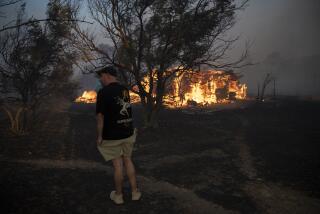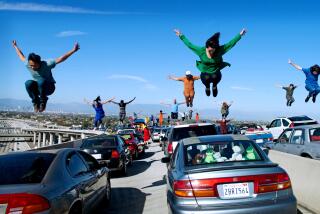Reminded of our impermanence here
An urban fire doesn’t really exist, as such, until it burns a building: until it uses architecture as fuel. At least that’s how politicians and news anchors chose to reassure us Tuesday night as flames raced across Griffith Park. Since the only structure known to be lost as evening fell was in the middle of the park, they kept telling us, the fire couldn’t be quite as dire as it looked on screen or from our frontyards. That structure, we learned later, was not even a building but an “equestrian bridge” -- a bit of architectural terminology new to many of us but somehow reassuringly, distantly pastoral.
Still, because the fire roared so close to the newly expanded Griffith Observatory, and because its drama grew as it threatened to jump out of the park and into residential neighborhoods, it produced a number of memorable images combining architecture and flames. They join a very long list of such pictures -- some artistic, some journalistic -- already fixed in our collective consciousness. You remember Joan Didion’s line: “The city burning is Los Angeles’ deepest image of itself.”
There was the observatory, most dramatic of all, seeming to stand right in the path of the fire, its three domes silhouetted against an orange backdrop. There were the groups of firefighters threading thick hoses through the living rooms of houses on the edge of the park, tromping across Oriental carpets in their boots and then standing on eucalyptus-shaded decks out back, battling the fire as it edged down the hillside.
And there was the realization, flashing quickly into the mind of anybody who has driven through those winding hillside streets, that the observatory wasn’t the only architectural landmark at risk. The fire also threatened Frank Lloyd Wright’s Ennis House and houses by Richard Neutra, R.M. Schindler, Gregory Ain, Craig Ellwood, Wright’s son Lloyd and Raphael Soriano -- all of them tucked between Los Feliz Boulevard and the southern boundary of Griffith Park and collectively making up one of the most important concentrations of residential architecture anywhere in the country.
Seeing the fire advance on those buildings brought dozens of similar images to mind: The warehouses and liquor stores burning in the Rodney G. King riots, fires whose images have been flickering through our minds because the press has been marking their 15th anniversary this week. And Ed Ruscha’s 1965-68 painting “The Los Angeles County Museum on Fire.” And its imaginary forebear, the painting called “The Burning of Los Angeles” that Tod Hackett, a central character in Nathanael West’s “The Day of the Locust,” is working on throughout that 1939 novel.
Even fictional links between fire and architecture in Los Angeles can be unsettling. They make clear that our favorite buildings are uniquely vulnerable, particularly the many landmarks that line the city’s canyons and foothills, where nature is liable to take its revenge on architecture on any hot and dry afternoon. It took an extraordinary act of destruction to produce the fiery collapse of New York’s World Trade Center towers in 2001. Architectural icons here are at constant risk, not just from fire but also from mudslides, earthquakes and riots, acts of man and God.
Wright’s textile-block Ennis House, for instance, is being painstakingly brought back from the edge of collapse after chunks of it slid down the hill in early 2005, when the hillsides above Los Feliz were saturated from a winter of nearly nonstop rain. It seemed a twist of fate cruelly suited to Los Angeles that two years later the house would be at risk again because a shortage of rainfall has left the same neighborhood desperately dry and ready to burn. Out of the mudslide and into the fire.
A stage-set quality
Disasters of all kinds underscore the temporary nature of the L.A. landscape and why so many of our architects have tried to avoid or even undermine a sense of permanence in their work. That effort is what makes Los Angeles architecture, paradoxically enough, both the most fake and the most honest of any American city’s. We put up eclectic, flimsy buildings here. But it is precisely their stage-set quality that makes them ring true. Our architects have long recognized their buildings can be burned, crushed by an earthquake or razed by a developer at any moment.
Artists and writers have looked at the city and its buildings the same way. Ruscha used LACMA to represent, at least in part, a certain false sense of monumentality and righteousness in American culture -- everything he and fellow L.A. artists hoped to reject not only in their work but also in the new artistic capital they were creating out here. As the critic Dave Hickey put it, Ruscha’s paintings of various buildings in flames -- around the time he burned LACMA on canvas, he also torched a gas station and a restaurant -- were the artist’s attempt to set “bastions of public morality ablaze with metaphysical fire.” A similarly anarchic spirit toward L.A. architecture fills Hackett’s Locust painting.
But our attitude toward architecture and fire -- and disaster of all kinds -- is not simply one that accepts or understands danger. It also finds beauty in it. How many of us have had the experience I did on Tuesday afternoon? Sitting in front of my computer around 2:30, I noticed that the quality of the sunlight streaming through the window seemed unusually beautiful -- if a little thin. Then I went outside and realized why: It was being filtered through clouds of smoke above Griffith Park as it burned.
When landmarks in L.A. do manage to avoid disaster and last, they become members of a small, select and rather fragile architectural group. The observatory, even with the addition of its new underground galleries, is pretty contained and fine-boned as public icons go. Didn’t that make the TV images on Tuesday evening, when it seemed briefly to be in real jeopardy, all the more poignant, somehow? The sense that the building, which covered only 27,000 square feet when it opened in 1935, was somehow too small, and too isolated, to protect itself? Designed to stand apart from the city, the observatory, during the fire, stood in for the city. It was clear that if it started burning, our houses might too.
Fictional meets factual
It often seems difficult, if not altogether meaningless, to separate the fictional versions of our city on fire from the journalistic ones. In that sense, the artwork that resonated most clearly this week was not Ruscha’s LACMA painting but a sly 2003 update of it in video form, titled “More Cinematic Los Angeles County Museum of Art on Fire,” by an artist named Joe Sola.
Sola’s looped piece seemed to predict this week’s coverage of the fire on TV and on the various blogs that posted picture after picture of flames and smoke. It has the same slightly blurry quality, the same sense that it had been produced quickly, in the middle of the action. Created in the old-fashioned isolation of the artist’s studio, Ruscha’s painting presents the burning museum in a vacuum. Sola updates it for the age of 24-hour news channels, cellphone cameras and so-called participatory media.
It also adds an audience, a small group of gawkers standing on the grass and looking up at the flames. Wasn’t there an unusual -- and discomfiting -- sense Tuesday night that we were watching the fire like some kind of drama? It is hard to imagine that there has ever been a scene outside of Southern California like the one that unfolded between about 8 and 10 p.m., as thousands of us on the east side of the city stood on our porches or at the end of our streets and watched a huge red-orange wall of flames moving down the hill in our direction -- and then woke up to learn that not a single building had been destroyed.
Days of the ‘Locust’
Near the beginning of “The Day of the Locust,” another of the novel’s characters, Homer Simpson -- yes, Matt Groening is a Nathanael West fan -- rents a small house in a canyon that is symbolic of the strange way that Los Angeles keeps insisting on pushing the urban world right up against the natural one. It is that very insistence that produced many of Tuesday’s strangest scenes, as the kind of raging wildfire we usually associate with an uninhabited area (a national park, say) bore down on some of this country’s most famous 20th century architecture.
“He rather liked the way the cottage was located,” West wrote of Homer’s rental. “It was the last house in the canyon and the hills rose directly behind the garage. They were covered with lupines, Canterbury bells, poppies, and several varieties of large yellow daisy. There were also some scrub pines, Joshua and eucalyptus trees. The agent told him he would see doves and plumed quail, but during all the time he lived there, he saw only a few large, black velvet spiders and a lizard. He grew very fond of the lizard.”
christopher.hawthorne@ latimes.com
More to Read
The biggest entertainment stories
Get our big stories about Hollywood, film, television, music, arts, culture and more right in your inbox as soon as they publish.
You may occasionally receive promotional content from the Los Angeles Times.











